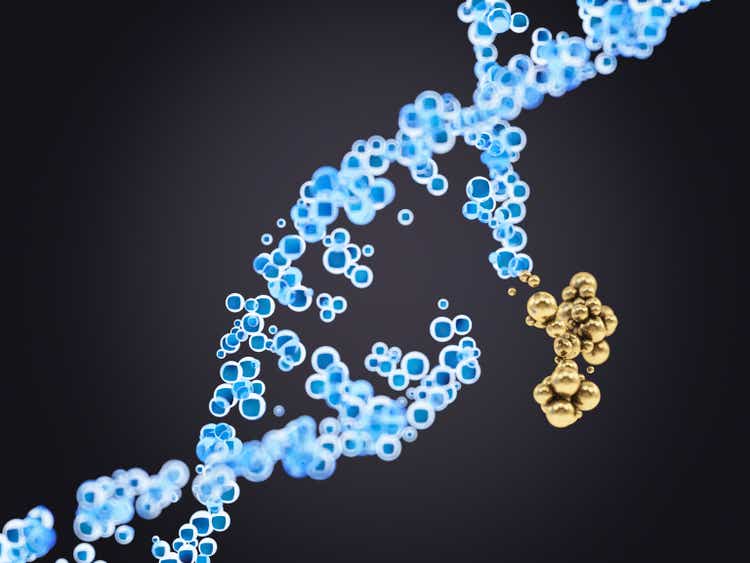asbe
Summary
VERVE-101 is an in vivo liver directed CRISPR base editing treatment for patients with heterozygous familial hypercholesterolemia. These patients have one mutant allele in the LDLR gene, which results in high LDL levels in the blood. Longer term, the condition results in blockages which obstruct blood flow and patients may have heart attacks and strokes. While the science is exciting, innovative and VERVE-101 has the potential to transform the treatment paradigm, it is also novel, unproven and a high risk approach. A recent FDA hold should refocus investors on the risk profile. Moreover, the company has only one clinical stage asset and thus investors face a concentrated bet on this asset. The valuation of Verve Therapeutics (NASDAQ:VERV) reflects the exciting science, but perhaps does not properly incorporate the risk profile.
Heterozygous Familial Hypercholesterolemia
While there is debate about the prevalence, heterozygous familial hypercholesterolemia may occur in 1 out of every 500 individuals. The disease is characterized by elevated plasma concentrations of LDL cholesterol and atherosclerotic plaques, along with premature heart disease. Currently, dietary modifications and a multi-drug regimen including statins are used. Adherence to treatment is poor and requires ongoing monitoring. The use of procedures including stents is also required in some cases. Diagnosis often occurs after a myocardial infarction at a young age due to atherosclerotic disease, or is made based on a family history.
Verve’s Novel Approach
This is a disease where there is widespread agreement that lowering LDL levels on an ongoing basis is a treatment goal. However, medicines to achieve this goal have limitations. Verve is utilizing base editing to inactivate the PCSK9 gene in the liver and in turn reduce LDL and lower the risk of adverse cardiovascular events.
Data is animal models appears promising. “In an in vivo proof-of-concept study, a single intravenous infusion of a base editor targeting PCSK9 achieved 67% whole liver DNA editing and resulted in an 89% reduction in blood levels of PCSK9 protein and a 59% reduction in blood levels of LDL-C in non-human primates (NH) at two weeks as compared to baseline.” The safety profile appears favorable, with liver safety monitoring revealing only transitory changes with a return to baseline. There was no evidence of gene editing in sperm or in the offspring of treated female mice.
Verve moved into human subjects and initiated the heart-1 trial in the UK and New Zealand. The independent Data Safety Monitoring Board (DSMB) has reviewed data from the first three patients treated with VERVE-101. Given adverse events were Grade 1 and there were no SAEs, the DSMB recommended dosing of the next cohort, who will receive a higher dose.
A Clinical Hold
Two days ago, the company was notified by FDA of a clinical hold on the IND for VERVE-101 in patients with heterozygous familial hypercholesterolemia. The company awaits written correspondence in the next 30 days from FDA explaining their concerns. This hold was announced on the same day a patient death was reported, which may have occurred after dosing of a CRISPR based treatment in a DMD patient. While DMD trials have been extremely challenging and have a poor safety record, investors face a high degree of clinical risk and uncertainty whenever a new modality is tested in humans. Unfortunately, optimal safety protocols often are developed after adverse events occur.
Finances
Verve Therapeutics is well-capitalized and reported $550 million in cash, which they expect to provide funding into 2025. Cash burn is approximately $45 m a quarter. $247.5 million in net proceeds was realized from the company’s issuance of common stock during the third quarter at $27 a share. The company also realized an initial payment of $60 m from Vertex Pharmaceuticals for a research collaboration on an undisclosed liver disease. Even after the sharp pullback in shares, the market cap stands at more than $1.3 Bn.
Conclusions
Verve Therapeutics is working on the cutting edge of science and is attempting to apply novel technology to a prevalent condition where there is substantial unmet need. Making an A-to-G change may seem simple, but this is a first-in-class treatment. In my view, the Vertex investment validates that scientists with deep knowledge have a favorable view of Verve’s potential.
Verve Therapeutics faces an FDA likely to be cautious given the novelty and unknown safety profile. A recent clinical hold is a setback that may refocus investors on the considerable risks of pioneering a truly novel treatment. The regulatory path for novel medicines is often unclear and evolves. For example, the FDA has been very conservative and requested extensive data for a gene therapies in hemophilia A. Hemophilia is a disease where there are effective SoC treatments available, so safety and durability are critical. Biomarin’s (BMRN) gene therapy has had several delays as FDA requests additional data. Currently, they are presenting 3-year data to regulators from a pivotal trial. They now have produced data for some patients out to 6 years and there have been several delays and the bar for approval appears unclear. Verve Therapeutics may need to produce very extensive long term data as well.
Even after the sharp pullback in the share price after the clinical hold, the market cap stands at more than $1.3 Bn. This is a steep valuation for a company which is an early stage company that has not produced substantial proof of concept data in human subjects yet. There is one clinical stage asset and thus investors also face a very concentrated bet on this asset. While I am impressed with the science and potential, the valuation provides little margin of safety for investors.


Be the first to comment